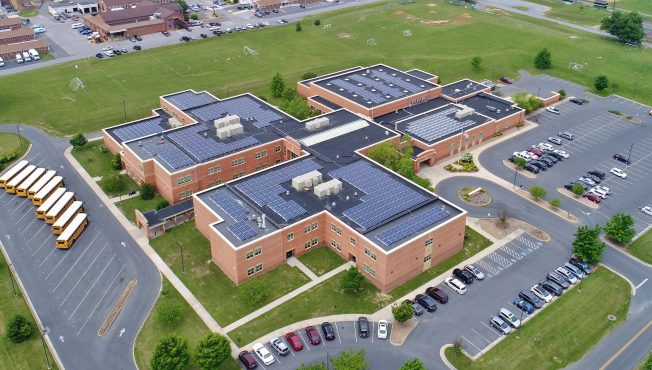by Ivy Main, cross posted from Power for the People VA
Virginia has chipped away at the barriers to renewable energy and started putting hundreds of millions of dollars into energy efficiency programs, thanks to laws like Solar Freedom, the Virginia Clean Economy Act (VCEA) and the Clean Energy and Community Flood Preparedness Act, which made Virginia part of the Regional Greenhouse Gas Initiative (RGGI).
But even a positive policy environment doesn’t flatten all barriers. At all levels of government — and for that matter, in homes and businesses — energy-saving projects get stalled by confusing information, lack of money or financing, layers of opaque bureaucracy or fear of uncertain outcomes.
Attacks on Virginia’s clean energy transition framework and utility reform get most of the ink during this legislative session, but some less-noticed bills are focused on moving ahead by removing stumbling blocks to clean energy and identifying funding.
I made a brief mention of some of these in my bill round-up last week, including House Joint Resolution 545 from Briana Sewell, D-Prince William, asking the Department of Energy to recommend ways to overcome barriers that keep local governments and their constituents from purchasing clean energy. There is also Senate Bill 1333 from Ghazala Hashmi, D-Richmond, to facilitate local clean energy projects for low- and moderate-income residents. Senate Bill 1419 from David Suetterlein, R-Roanoke, would allow retail choice in renewable energy purchasing, and Senate Bill 949 from Chap Petersen, D-Fairfax, would allow residents to access low-cost public financing of clean energy.
The shared solar bills I covered last week also allow local governments to participate. And although I’m not tracking them myself, there are other bills that encourage local resiliency planning, give localities authority to require electric vehicle charging infrastructure or support transit solutions.
Overwhelmingly — but not exclusively! — the bills this year that try to move the ball forward on clean energy come from Democrats, a bad sign when the House and governor are Republican. I have seen many bills die in committee for reasons that have little to do with the bill, and Gov. Youngkin notoriously vetoed bills last year seemingly as a “personal and political move” against the bills’ patron senator. It’s also a short session this year, so if a bill is complicated or has opposition from favored industries, it goes into committee with a strike against it.
But many of these bills support private investments or save money for taxpayers, which are thankfully still bipartisan priorities. And some energy innovations are now mainstream across Virginia, in red counties as well as blue. Among these are solar schools.
So let’s take a deeper look at one piece of legislation, the solar school roofs study at the center of Senate Bill 848 from Barbara Favola, D-Arlington, and House Bill 1852 from Suhas Subramanyam, D-Loudoun.

I wish they all could be solar schools
In the summer of 2021, I was dismayed to learn that the school board for the city of Norfolk had been told none of their brand-new schools could be outfitted with solar panels because the roofs weren’t designed to take the extra weight. As a result, Norfolk could not do what dozens of school districts across Virginia have been doing: installing solar arrays to provide some or all of the energy the school consumed, saving money for taxpayers and giving students hands-on exposure to a fast-growing technology with terrific career potential.
What a missed opportunity, and yet, Norfolk wasn’t alone. I soon learned about a new school in Richmond where educators were eager for solar, but the steep pitch of the roof on the main part of the building wasn’t suitable. That left only a flat-roofed side wing that couldn’t hold enough panels to meet more than a fraction of the school’s needs.
From conversations with architects and solar developers, I know that building a school with a roof that can hold solar panels doesn’t have to be an added expense; mainly, you just have to plan for it. Wyck Knox, the architect who designed Arlington’s two net-zero energy schools (among others), says even building a school that can produce as much energy as it uses doesn’t have to cost more, if you simply approach the design process with that goal.
Designing a school with a solar-ready roof pays off when the school district enters a power purchase agreement (PPA) with a solar company that installs and owns the solar array. The school pays just for the electricity it produces, typically at a rate lower than what the utility charges.
As of this year, the financing options have expanded. The Inflation Reduction Act allows tax-exempt entities like local governments and schools to claim federal tax credits for renewable energy and batteries directly.
So why aren’t all schools solar schools? The answers might differ from one school district to the next, but generally it’s because nobody thought of it at the right time, or they don’t know how to go about it, or the right people aren’t on board. One stubborn facilities manager can stall a project indefinitely.
The U.S. Department of Energy says energy is the second largest expense for schools, after teacher salaries. Taxpayers should be able to expect their school districts will pursue strategies like onsite solar that reduce energy costs.
Personally, I support requiring school districts to, at the very least, analyze whether they could save money with solar roofs before they lock in designs that don’t include them. However, House Republicans killed an effort last year to impose such a requirement. And some school officials say it isn’t needed because they want to do solar; they just need help with the process.
With that in mind, Senate Bill 848 and House Bill 1852 task the Commission on School Construction and Modernization with developing recommendations to help schools incorporate renewable energy in the construction or renovation of schools.
The commission itself recommended several pieces of legislation that are now before the General Assembly, including some around construction funding. That should make it easier to integrate solar recommendations into their other work.
Favola said, “I am extraordinarily excited about the possibility of providing school systems with technical assistance on how to incorporate solar and other renewable energy components in their renovations and new buildings.”
You and me both, Senator. You and me both.
This article was originally published in the Virginia Mercury on January 26, 2023.
Update January 27: I may have given Republicans too much credit, at least those in the House. Although Senator Favola’s bill sailed through a Senate committee and is headed for a floor vote, a House subcommittee killed Delegate Subramanyam’s companion bill–in spite of a long line of speakers in support and no opposition. It was a bad meeting for Subramanyam; his shared solar bill also died in that committee. Senator Sutterlein’s retail competition bill has also been killed in a bipartisan vote in Senate Commerce and Labor, a Dominion-friendly committee.



![[UPDATED 12/24] After Dept. of Interior Puts Hold on Five East Coast Offshore Wind Farms, Including Coastal Virginia Offshore Wind, VA Senate Majority Leader Scott Surovell Rips “Trump’s blatantly illegal political payback to VA for voting for [Abigail Spanberger]”](https://bluevirginia.us/wp-content/uploads/2025/12/surovellwind-238x178.jpg)









![[UPDATED 12/24] After Dept. of Interior Puts Hold on Five East Coast Offshore Wind Farms, Including Coastal Virginia Offshore Wind, VA Senate Majority Leader Scott Surovell Rips “Trump’s blatantly illegal political payback to VA for voting for [Abigail Spanberger]”](https://bluevirginia.us/wp-content/uploads/2025/12/surovellwind-100x75.jpg)

